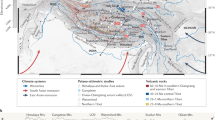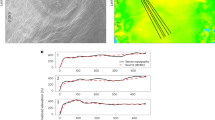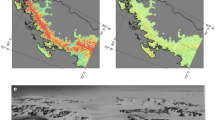Abstract
Arising from: D. B. Rowley & B. S. Currie Nature 439, 677–681 (2006); Rowley & Currie reply
The determination of palaeo-elevation has emerged in the past 15 years as an important tool for constraining physical processes that govern the formation of mountain belts. Rowley and Currie1 report palaeo-elevations for the Lunpola basin within the Tibetan plateau and claim that these elevations are incompatible with 'mantle-thickening models' for mountain formation. We show here that their data do not support this conclusion and, indeed, are consistent with its opposite. The Tibetan plateau could have risen by a kilometre or more as its dense lower lithosphere sank into the underlying mantle.
Similar content being viewed by others
Main
If continental lithosphere is thickened to form a mountain belt, the lower part of the lithosphere, which is inherently unstable because it has higher density than its underlying mantle, may abruptly sink and be replaced by mantle that is less dense2,3. Depending on the thickness of lithosphere that is replaced, the Earth's surface can rise by 1,000 m to perhaps 2,500 m (refs 2,3). (In this communication, all references to elevation are to the height of the land surface above sea level; change in sea level between 35 Myr and the present is negligible in this context.) The essence of Rowley and Currie's argument is that, because their inferred elevations for the Lunpola basin at about 35 Myr (4,850 m (+1,630/−1,435 at 95% confidence), 4,260 m (+1,480/−1,420), and 4,050 m (+1,420/−1,220)) are similar to its present-day elevation (4,567−4,718 m), the surface of the Tibetan plateau cannot have risen appreciably after 35 Myr, and that convective removal of lower lithosphere could not have occurred.
Rowley and Currie's1 argument assumes that the elevation history of the Lunpola basin, which forms only a very small part of the Tibetan plateau, is representative of the whole. The position of the basin renders that assumption doubtful: it lies close to the northern edge of the Lhasa block, which was part of an Andean margin through late Cretaceous and early Tertiary time, and probably achieved a high elevation much earlier than the rest of the plateau4,5,6.
Rowley and Currie's1 argument also neglects the influence of crustal thinning on the surface height of the plateau since 35 Myr ago. Extensional faulting began on the plateau at about 8–15 Myr3,7,8, and summation of moment tensors of earthquakes suggests that roughly half of the present-day rate of east–west extension in Tibet represents vertical thinning9,10. Because of isostasy, crustal thinning causes the surface elevation to drop. The present rate of thinning is about 4 × 10−9 per yr; if this rate had operated for the past 8–15 Myr, then the crust would have thinned by 2.5–5 km and, in the absence of other processes, the height of the land surface would have decreased by about 500–1,000 m (refs 2, 3). Because crustal thinning extracts gravitational potential energy from the plateau2,3, the present-day rate of thinning is probably lower than the average rate, so the total decrease in surface height may have been greater than we estimate.
The average of Rowley and Currie's1 three estimates of palaeo-elevation, at 35 Myr, for sites in the Lunpola basin is about 250 m lower than the present-day elevation of the basin and, at 8–15 Myr, surface heights in the plateau were higher than they are now by about 500–1,000 m. Thus, ignoring uncertainties, Rowley and Currie's1 palaeo-altitudes are consistent with a rise of the Lunpola basin by about 750–1,250 m at some time between 35 ± 5 Myr and the onset of crustal thinning at around 8–15 Myr. Accounting for departures from assumptions in Rowley and Currie's estimates1 (such as differences in initial δ18O, in paths of moisture transport, in evaporation of precipitation, and so on) could make the uncertainties larger than quoted, and permit greater surface uplift. Thus, Rowley and Currie's results do not disprove 'mantle-thickening models' for the formation of the plateau: indeed, when combined with the effect of crustal thinning on the surface elevation of the plateau in the past 15 Myr, the data offer support for the idea that convective removal of mantle lithosphere contributed to the high surface elevation of the present-day Tibetan plateau.
References
Rowley, D. B. & Currie, B. S. Nature 439, 677–681 (2006).
England, P. & Houseman, G. J. Geophys. Res. 94, 17561–17579 (1989).
Molnar, P., England, P. & Martinod, J. Rev. Geophys. 31, 357–396 (1993).
England, P. C. & Searle, M. Tectonics 5, 1–14 (1986).
Murphy, M. A. et al. Geology 25, 719–722 (1997).
Kapp, P., Yin, A., Harrison, T. M. & Ding, L. Geol. Soc. Am. Bull. 117, 865–878 (2005).
Harrison, T. M., Copeland, P., Kidd, W. S. F. & Yin, A. Science 255, 1663–1670 (1992).
Blisniuk, P. M. et al. Nature 412, 628–632 (2001).
Molnar, P. & Chen, W.-P. J. Geophys. Res. 88, 1180–1196 (1983).
Molnar, P. & Lyon-Caen, H. Geophys. J. Int. 99, 123–153 (1989).
Author information
Authors and Affiliations
Corresponding author
Rights and permissions
About this article
Cite this article
Molnar, P., Houseman, G. & England, P. Palaeo-altimetry of Tibet. Nature 444, E4 (2006). https://doi.org/10.1038/nature05368
Published:
Issue Date:
DOI: https://doi.org/10.1038/nature05368
This article is cited by
-
Palaeo-altimetry of Tibet (reply)
Nature (2006)
Comments
By submitting a comment you agree to abide by our Terms and Community Guidelines. If you find something abusive or that does not comply with our terms or guidelines please flag it as inappropriate.



